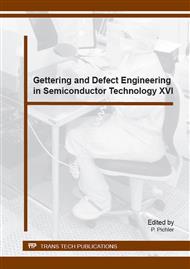[1]
G.D. Watkins, Defects in irradiated silicon: EPR and electron-nuclear double resonance of interstitial boron, Phys. Rev. B 12 (1975) 5824-5839.
DOI: 10.1103/physrevb.12.5824
Google Scholar
[2]
P.M. Mooney, L.J. Cheng, M. Süli, J.D. Gerson, J.W. Corbett, Defect energy levels in boron-doped silicon irradiated with 1-MeV electrons, Phys. Rev. B 15 (1977) 3836-3843.
DOI: 10.1103/physrevb.15.3836
Google Scholar
[3]
A.R. Bean, S.R. Morrison, R.C. Newmann, R.S. Smith, Electron irradiation damage in silicon containing high concentrations of boron, J. Phys. C: Solid State Phys. 5 (1972) 379-400.
DOI: 10.1088/0022-3719/5/4/005
Google Scholar
[4]
J.R. Troxell, G.D. Watkins, Interstitial boron in silicon: A negative-U system, Phys. Rev. B 22 (1980) 921-931.
Google Scholar
[5]
R.D. Harris, J.L. Newton, G.D. Watkins, Negative-U defect: Interstitial boron in silicon, Phys. Rev. B 36 (1987) 1094-1104.
DOI: 10.1103/physrevb.36.1094
Google Scholar
[6]
A.K. Tipping, R.C. Newman, An infrared study of the production, diffusion and complexing of interstitial boron in electron-irradiated silicon, Semicond. Sci. Technol. 2 (1987) 389-398.
DOI: 10.1088/0268-1242/2/7/001
Google Scholar
[7]
K. Laithwaite, R.C. Newman, D.H.J. Totterdell, Interstitial defects involving boron in irradiated silicon, J. Phys. C: Solid State Phys. 8 (1975) 236-242.
DOI: 10.1088/0022-3719/8/2/016
Google Scholar
[8]
K. Thonke, J. Weber, J. Wagner, R. Sauer, Origin of the 1. 080 eV (I2) photoluminescence line in irradiated silicon, Physica B 116 (1982) 252-257.
DOI: 10.1016/0378-4363(83)90255-3
Google Scholar
[9]
P.J. Drevinsky, C.E. Caefer, S.P. Tobin, J.C. Mikkelsen Jr., L.C. Kimerling, Influence of oxygen and boron on defect production in irradiated silicon, Mat. Res. Soc. Symp. Proc. 104 (1988) 167-172.
DOI: 10.1557/proc-104-167
Google Scholar
[10]
L.C. Kimerling, M.T. Asom, J.L. Benton, P.J. Drevinsky, C.E. Caefer, Interstitial defect reactions in silicon, Materials Science Forum 38-41 (1989) 141-150.
DOI: 10.4028/www.scientific.net/msf.38-41.141
Google Scholar
[11]
J. Adey, J.P. Goss, R. Jones, P.R. Briddon, Interstitial boron defects in Si, Physica B 340-342 (2003) 505-508.
DOI: 10.1016/j.physb.2003.09.147
Google Scholar
[12]
J. Adey, J.P. Goss, R. Jones, P.R. Briddon, Identification of boron clusters and boron-interstitial clusters in silicon, Phys. Rev. B 67 (2003) 245325 (1-5).
DOI: 10.1103/physrevb.67.245325
Google Scholar
[13]
A. Carvalho, R. Jones, J. Coutinho, P.R. Briddon, Ab initio calculation of the local vibrational modes of the interstitial boron-interstitial oxygen defect in Si, J. Phys.: Condens. Matter. 17 (2005) L155-L159.
DOI: 10.1088/0953-8984/17/17/l01
Google Scholar
[14]
P. Becker, H. -J. Pohl, H. Riemann, N. Abrosimov, Enrichment of silicon for a better kilogram, Phys. Status Solidi A 207 (2010) 49–66.
DOI: 10.1002/pssa.200925148
Google Scholar


